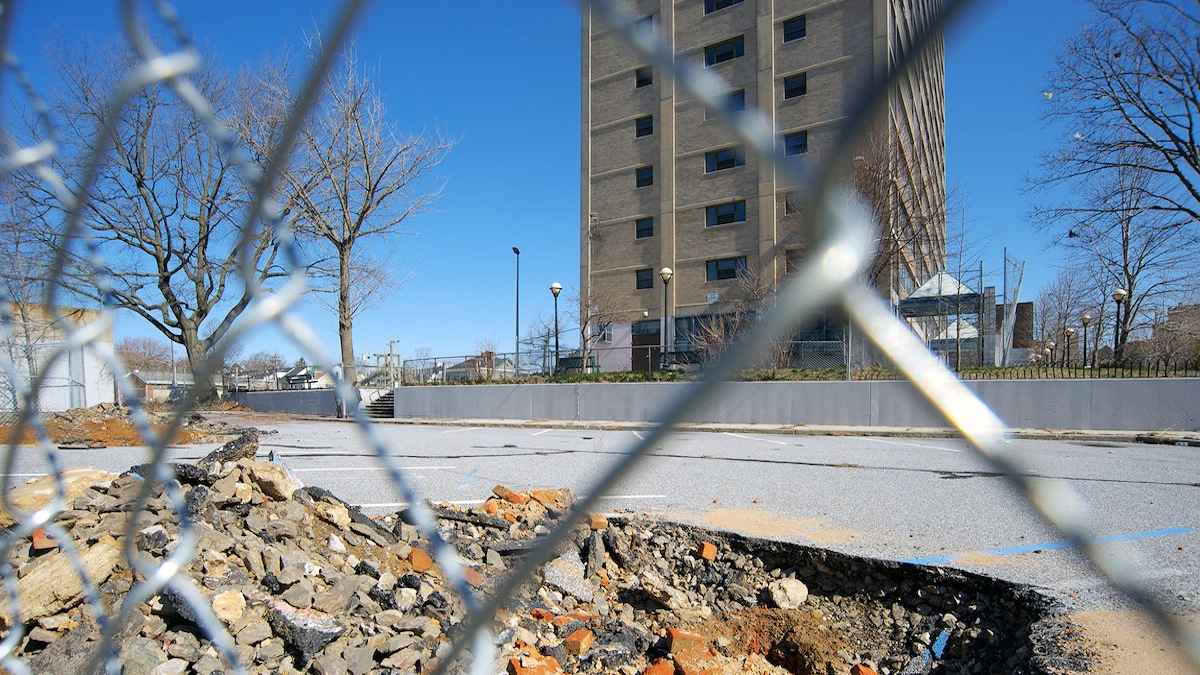Looming Queen Lane Apartments demo considered ‘huge weight lifted off the community’

Bricks and debris are visible at one of the Potter's Field excavation sites behind the long-shuttered Queen Lane Apartments tower. (Bas Slabbers/for NewsWorks, file)
Corliss Gray couldn’t be happier that construction vehicles will soon start rumbling and beeping across the street from her Germantown home.
“I welcome the noise,” Gray said, “because it’s progress.”
A long wait
For months now, the long-time Penn Street resident has stared out at Queen Lane Apartments and wondered whether the shuttered public-housing high-rise would ever be demolished.
The Philadelphia Housing Authority closed the 16-story property at West Queen Lane and Pulaski Ave. more than two years ago to make way for a 55-unit low-density development.
Originally scheduled to come down in Aug. 2012, the discovery of a “Potter’s Field” behind the tower changed everything.
The mid-18th century burial ground — the final resting place for “strangers, Negroes and Mulattoes” — added a complex layer to a mandatory historical review of the site.
At the request of residents, PHA also agreed to build around the cemetery and paid for two archeological surveys to definitely determine its boundaries.
All of it left the music Gray’s been after on what, at times, felt like permanent pause.
Enough’s enough
She couldn’t stand it. PHA’s waiting list has thousands of names of people waiting for housing.
“We need that 55 units,” said Gray, a PHA resident for more than half a century. “We need every little house that we can get.”
In late February, Gray’s wish came true after a critical legal agreement between PHA, the U.S. Department of Housing and Urban Development, neighbors and other stakeholders was finalized.
The so-called programmatic agreement maps out what actions will be taken going forward if any historic resources are found either during additional archaeological digs, demolition or construction.
To date, no human remains have been discovered at the site and nothing has indicated that the burial ground extends beyond the roughly two-acre footprint found on a pair of historical maps of the area.
PHA comment
HUD can now give PHA the green light to prepare for demolition.
“PHA is excited to be able to move forward on developing Queen Lane,” said agency spokesperson Nichole Tillman of the $22 million project. “With recent record rates of high poverty and deep poverty, the City of Philadelphia is in great need of affordable housing.
“Currently, PHA has more than 100,000 people on its waiting list and these 55 units will provide homes for those who need it most.”
A plaque or historic marker will designate the “Potter’s Field” portion of the site, she said.
Demolishing Queen Lane Apartments wasn’t always guaranteed.
In September, PHA’s Executive Director Kelvin Jeremiah told NewsWorks that the agency was “seriously considering” gutting and revamping the high-rise instead of tearing it down.
At the time, the agency had already spent more than $1 million of the project’s price tag. Rehabbing the building — a cheaper alternative — was starting to look more and more appealing, especially as PHA grappled with a drop in federal housing dollars.
Neighbors react
Local resident Kristin Haskins-Simms, who helped fight to preserve the Potter’s Field, said she is glad the agency didn’t go that route.
She’s also “praying” that the new development represents the start of a more positive chapter for Queen Lane Apartments and the still-struggling blocks that surround it.
“It means a lot,” said Haskins-Simms when asked about the demolition. “It cast a shadow … physically, mentally and emotionally. For that to come down, I think that’ll be a huge weight lifted off the community.”
The nearly 60-year old building has a long history of crime. Drug-use and dealing was commonplace. There had been shootings inside.
Haskins-Simms said the pressure will be on PHA to ensure the new development doesn’t become home to the same activities.
“The minute something goes on, they’re going to hear about it from the residents,” she said.
Gray, for her part, is more confident that the new development will be a welcomed change that will add value to the neighborhood. She’s seen it happen after other PHA high-rises were demolished.
“The whole neighborhood is going to feel it,” she said. “They don’t realize it, but once that new complex gets built … people will be pleased.”
Timeline uncertain
It’ll be at least a few months before the tower becomes the 20th high-rise PHA has demolished.
At a HUD meeting in December, Michael Johns, PHA’s acting deputy executive director for operations, told NewsWorks that the preparation process for demolitions typically takes three months.
HUD spokeswoman Niki Edwards said the agency does not yet have a “time frame for the demolition approval.”
Construction is expected to take a year.
WHYY is your source for fact-based, in-depth journalism and information. As a nonprofit organization, we rely on financial support from readers like you. Please give today.





